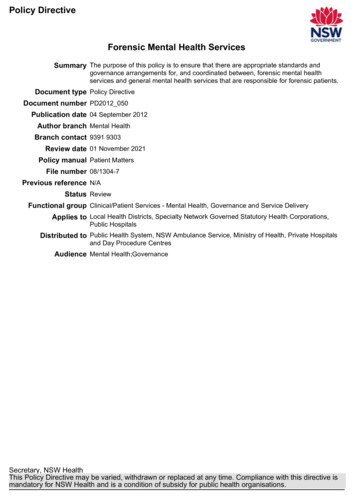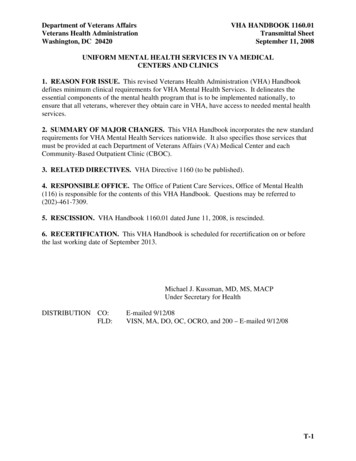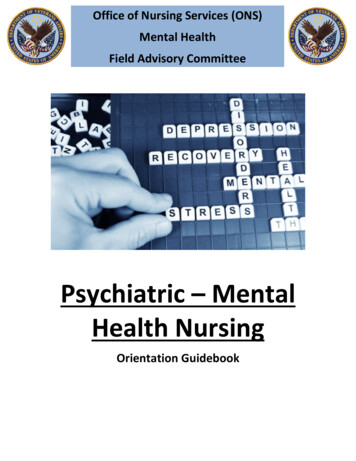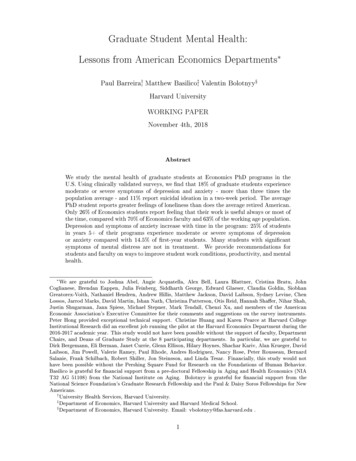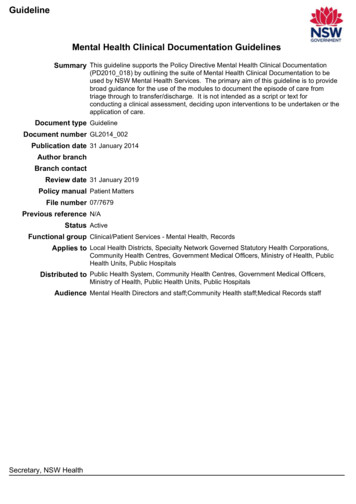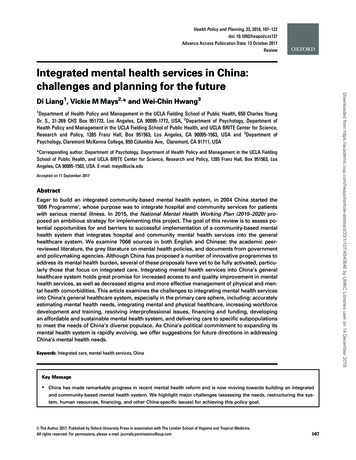
Transcription
Health Policy and Planning, 33, 2018, 107–122doi: 10.1093/heapol/czx137Advance Access Publication Date: 13 October 2017ReviewIntegrated mental health services in China:challenges and planning for the futureDownloaded from 3/1/107/4540646 by UMKC Libraries user on 14 December 2018Di Liang1, Vickie M Mays2,* and Wei-Chin Hwang31Department of Health Policy and Management in the UCLA Fielding School of Public Health, 650 Charles YoungDr. S., 31-269 CHS Box 951772, Los Angeles, CA 90095-1772, USA, 2Department of Psychology, Department ofHealth Policy and Management in the UCLA Fielding School of Public Health, and UCLA BRITE Center for Science,Research and Policy, 1285 Franz Hall, Box 951563, Los Angeles, CA 90095-1563, USA and 3Department ofPsychology, Claremont McKenna College, 850 Columbia Ave, Claremont, CA 91711, USA*Corresponding author. Department of Psychology, Department of Health Policy and Management in the UCLA FieldingSchool of Public Health, and UCLA BRITE Center for Science, Research and Policy, 1285 Franz Hall, Box 951563, LosAngeles, CA 90095-1563, USA. E-mail: mays@ucla.eduAccepted on 11 September 2017AbstractEager to build an integrated community-based mental health system, in 2004 China started the‘686 Programme’, whose purpose was to integrate hospital and community services for patientswith serious mental illness. In 2015, the National Mental Health Working Plan (2015–2020) proposed an ambitious strategy for implementing this project. The goal of this review is to assess potential opportunities for and barriers to successful implementation of a community-based mentalhealth system that integrates hospital and community mental health services into the generalhealthcare system. We examine 7066 sources in both English and Chinese: the academic peerreviewed literature, the grey literature on mental health policies, and documents from governmentand policymaking agencies. Although China has proposed a number of innovative programmes toaddress its mental health burden, several of these proposals have yet to be fully activated, particularly those that focus on integrated care. Integrating mental health services into China’s generalhealthcare system holds great promise for increased access to and quality improvement in mentalhealth services, as well as decreased stigma and more effective management of physical and mental health comorbidities. This article examines the challenges to integrating mental health servicesinto China’s general healthcare system, especially in the primary care sphere, including: accuratelyestimating mental health needs, integrating mental and physical healthcare, increasing workforcedevelopment and training, resolving interprofessional issues, financing and funding, developingan affordable and sustainable mental health system, and delivering care to specific subpopulationsto meet the needs of China’s diverse populace. As China’s political commitment to expanding itsmental health system is rapidly evolving, we offer suggestions for future directions in addressingChina’s mental health needs.Keywords: Integrated care, mental health services, ChinaKey Message China has made remarkable progress in recent mental health reform and is now moving towards building an integratedand community-based mental health system. We highlight major challenges (assessing the needs, restructuring the system, human resources, financing, and other China-specific issues) for achieving this policy goal.C The Author 2017. Published by Oxford University Press in association with The London School of Hygiene and Tropical Medicine.VAll rights reserved. For permissions, please e-mail: journals.permissions@oup.com107
108Introductionalso remain in mental health coverage between rural and urbanareas and across regions (Patel et al. 2016).To improve access to care, reduce stigma, and manage physicaland mental health comorbidities, it has been argued that integratingmental health services into China’s general healthcare system, especially the primary care sphere, needs to be a top priority (Tse et al.2013; The Lancet 2015; Wong et al. 2014). China has also demonstrated a political commitment to integrating mental health servicesinto its general healthcare system, as proposed in the first ‘NationalMental Health Working Plan (2002–2010)’ and the latest ‘NationalMental Health Working Plan (2015–2020)’ released on June 18,2015 (The State Council 2002, 2015a). However, integrating mentalhealth services into primary care for both serious and common mental illnesses remains an as-yet unfulfilled aspiration for the government (Ministry of Health of the PRC 2008a; Tse et al. 2013).Remaining obstacles include perceived stigma in seeking mentalhealth services, an inadequate mental health workforce, insufficientfunding resources, and a fragmented hospital-centered mentalhealthcare delivery system (Patel et al. 2016; Tse et al. 2013; Yuet al. 2010).Integrating mental health services into the general healthcare system is aligned with the goals of China’s current healthcare reform.Since 2009, the country has invested substantially in expanding itshealthcare infrastructure (e.g. primary care facilities) and achievednearly universal health insurance coverage (Yip and Hsiao 2014).The World Bank Group, WHO, and three ministries of the Chinesecentral government [the Ministry of Finance, the National Healthand Family Planning Commission (NHFPC) (previously known asthe Ministry of Health), and the Ministry of Human Resources andSocial Security] recently released a report entitled ‘Healthy China:Deepening Health Reform in China, Building High-Quality andValue-Based Service Delivery’. This report recommended that Chinaadopt a reformed delivery model, referred to as ‘people-centeredintegrated care (PCIC)’ (The World Bank Group 2016). Peoplecentered care is ‘an approach to care that consciously adopts the perspectives of individuals, families, and communities and sees them asparticipants as well as beneficiaries of trusted health systems that respond to their needs and preferences in humane and holistic ways’(WHO 2015). Integrated care consists of ‘health services that aremanaged and delivered in a way that ensures people receive a continuum of health promotion, disease prevention, diagnosis, treatment, disease management, rehabilitation and palliative careservices, at the different levels and sites of care within the health system and according to their needs throughout their life course’(WHO 2015). The backbone of the proposed PCIC model is a wellfunctioning primary care system that is integrated with large hospitals through ‘formal linkages, good data, and information sharingamong providers and between providers and patients’.Implementing the proposed reforms can also offer a window of opportunity to transform China’s mental health services into an integrated community-based mental healthcare delivery system, whichcan also become a model for China’s future healthcare reform.To our knowledge, no in-depth review has been undertaken onthe potential windows of opportunity for or barriers to providingintegrated mental health services for patients with serious or common mental illness in China. The goal of this review, therefore, is toassess the potential opportunities for and barriers to successful implementation of an integrated community-based mental health system based on integrating mental health services into the generalDownloaded from 3/1/107/4540646 by UMKC Libraries user on 14 December 2018Although mental disorders are significant contributors to globalhealth problems, most people affected in low- and middle-incomecountries do not have access to treatment (Whiteford et al. 2013;World Health Organization [WHO] 2013). Even in some high- tomoderately high-income countries such as China and the USA, mental health disorders and their treatment remain significant burdens.To close the gap in access to mental health services worldwide,WHO, in its Comprehensive Mental Health Action Plan 2013–2020(WHO 2013), highlighted an objective for all countries to achieveby 2020: ‘to provide comprehensive, integrated and responsive mental health and social care services in community-based settings’.Several global initiatives reaffirm that integrating primary care andmental health services is one of the most viable options for improvinghealthcare (WHO and World Organization of Family Doctors 2008).Because most people around the world seek psychiatric help from primary care facilities (and conceptualize and manifest their illness bothphysically and mentally), integrating physical and mental health services can be an effective method to coordinate care, increase referrals,decrease stigma and improve mental health treatment outcomes(deGruy 1996; Collions et al. 2010). For instance, the USA is currentlymaking advances in improved patient-centered care by integratingmental and physical health services in the primary care setting (Barryand Huskamp 2011; Bao et al. 2013; Smith et al. 2013; Domino et al.2015). Integrated care programmes in the USA contain several elements: screening, patient education, patient self-management, psychotherapy, mental health specialist availability, clinical and adherencemonitoring and standardized follow-up care (Butler et al. 2008; Scharfet al. 2013; Manderscheid and Kathol 2014).A systematic review of 57 trials treating a variety of psychiatricillnesses found that integrated chronic care models can improvemental and physical outcomes for individuals with mental disordersacross a wide variety of care settings without increasing cost(Woltmann et al. 2012). The review also showed that integratingservices can lead to improved access to and quality of care, detectionand prevention efforts, coordination and communication, costeffective streamlining of services, and informed treatment modelsthat take into account comorbid physical and mental health issues(Woltmann et al. 2012).China has shown a strong commitment to mental health reform.In December 2004, the national ‘686 Programme’, named after theinitial funding allocation of 6.86 million yuan (Chinese currency;equivalent to US 1 million today), also called ‘Central GovernmentSupport for the Local Management and Treatment of SeriousMental Illness Project’, was initiated to integrate hospital and community services (Ma 2012). Then on 1 May 2013, China’s ‘MentalHealth Law’ went into effect (Chen et al. 2012; National People’sCongress 2012), the first-ever national law on mental health and alandmark policy for protecting patient rights and improving mentalhealth services (Xiang et al. 2012).Despite these historic milestones, implementation of these initiatives and their potential to create reforms remain uncertain. Manychallenges still exist in closing treatment gaps for both serious andcommon mental illnesses. For common mental disorders, contact(i.e. patients having contact with any general or mental healthcareproviders) is low, as is provision of mental health services (i.e. delivery of evidence-based interventions, patient adherence to treatmentand retention in care and clinical and social outcomes). Even for serious mental illnesses, the effective coverage is low. Large disparitiesHealth Policy and Planning, 2018, Vol. 33, No. 1
Health Policy and Planning, 2018, Vol. 33, No. 1healthcare system (especially the primary care sphere) and on integrating hospital-based with community-based mental health services. Thus, we first review the basis for China’s future integratedmental health services and then review its recent mental health reforms, which could become the foundation for building an integrated community-based mental health system. We also review thecurrent challenges to integration and offer future directions for addressing China’s mental health needs.Data sources and search strategySystematic reviews can inform policymaking by clarifying the problem and its causes, assessing potential policy options, and identifyingimplementation considerations (Langlois et al. 2015). In this study,our search strategy was informed by the WHO Health SystemsFramework (WHO 2007). This framework was developed as both atool to understand health systems and as a guide to strengthen them.According to this framework, a health system has several buildingblocks: service delivery; health workforce; information; medicalproducts, vaccines, and technologies; financing; and leadership andgovernance (stewardship). The overall goals of a healthcare systemconsist of improved health, responsiveness, social and financial riskprotection and improved efficiency. Access to and coverage of healthservices, along with quality and safety of care, can also influencehow a health system achieves its goals.The search strategy sought to identify publications related to theburden of mental illness, financing of mental health services, themental health workforce, governance, and delivery of mental healthservices in China (see Table 1). Because of the relatively limitednumber of peer-reviewed papers discussing mental health services inChina, the scope of this review is intentionally wide.We searched papers published from 2000 to 2016 using (i)English-language sources, including PubMed, Web of Science,Google, and Google Scholar for English publications, and (ii)Chinese-language sources, including the China Knowledge ResourceIntegrated Database, Wanfang Data through the National LibraryTable 1. Key words and components search strategy using theWHO health systems frameworkComponentsExample of key hworkforce‘China AND mental health policy,’ ‘China ANDmental health law’‘China AND mental health AND financing,’ ‘ChinaAND mental health AND health insurance’‘China AND mental health AND specialty,’’ChinaAND mental health AND human resources,’‘China AND mental health AND training’‘China AND mental health,’ ‘China AND psychiatric disorders’ and ‘China AND mental healthAND comorbidity,’ ‘China AND mental healthAND children,’ ‘China AND mental health ANDurbanization,’ ‘China AND mental health ANDethnic minority’‘China AND mental health services,’ ‘China ANDcommunity-based mental healthcare,’ ‘ChinaAND integrated mental healthcare,’ ‘China andintegrated mental health services’, ‘686Programme,’ ‘China AND mental health ANDaging,’ ‘China AND mental health AND primarycare’Informationand researchService deliveryof China, the National Social Science Database and Baidu Scholarfor Chinese publications. Most academic and grey literature onChina’s mental health policy was in Chinese.Online searches of the grey literature (e.g. policies, reports, webpages) were performed by reviewing the publicly accessible repositories of key Chinese government agencies, bilateral/multilateralagencies, and other relevant organizations/institutions active in thecountry. These included the NHFPC of the People’s Republic ofChina (PRC) (formerly the Ministry of Health), the Ministry of CivilAffairs of the PRC, the China Disabled Persons’ Federation, WHO,and Peking University’s Sixth Hospital. Additional relevant sourcesof grey literature were identified through snowballing of references.Study selection and data abstractionWe included original studies, as well as studies and publications ofcommentaries, views, and experiences related to the mental healthburden, comorbidity of physical and mental disorders, mental healthservices (access, cost, quality, financing, delivery, and monitoring),and mental health policies and programmes. We excluded publications on mental health services within other systems (e.g. education,substance abuse) and focused primarily on mental health serviceswithin the healthcare system. We also excluded publications relatedto the Chinese population outside the mainland (e.g. immigrants inthe USA) and studies with small sample sizes (e.g. case studies) (seeFigure 1).We found a total of 2897 English-language articles and 4169Chinese-language articles. Relevant studies were identified by titleand abstract screening. After excluding duplicate and irrelevantpapers by reviewing titles and abstracts, 235 papers were reviewedin full text for this article (Supplementary Appendix).Retrieved studies were abstracted by all three authors accordingto publishing characteristics (e.g. year of publication, location of research). Additionally, the study design and main findings were extracted for original studies, and key arguments were abstracted forother types of publications (e.g. commentaries) according to theWHO Health Systems Framework (WHO 2007).Although the first author did a large portion of the searching andabstracting and all of the translating, the second author checked andalso abstracted papers specifically in the area of US mental healthand mental health policy implications, and the third author checkedand abstracted papers that compared mental health in the USA andChina. Notably, the first author, whose native language is Chinese, didthe screening and abstracting of all Chinese-language publications.ResultsWhy an integrated and community-based mental healthsystem in China is neededTreatment gaps in serious and common mental illnessesTo close treatment gaps in mental health is one of the most importantreasons for integrating the mental health services system into China’sgeneral healthcare system. We focused on access to care, as little research existed on the quality of available mental health services inChina. Only a very small proportion of patients with mental disordersactually sought professional care in China. The Chinese WorldMental Health Survey (2001–02) conducted in Beijing and Shanghaifound that only 3.4% of respondents with a psychiatric disordersought professional help during the previous 12 months (Shen et al.2006). Similarly, in a large epidemiologic study conducted in fourprovinces [Gansu, Qinghai, Shandong and Zhejiang (2001–05)—63 004 participants aged 18 years or older in 96 urban neighborhoodsDownloaded from 3/1/107/4540646 by UMKC Libraries user on 14 December 2018Methods109
110Health Policy and Planning, 2018, Vol. 33, No. 1and 267 rural villages], only 8% of individuals with mental disorderssought professional help within the general healthcare setting, andonly 5% sought help from mental health professionals (mainlyhospital-based psychiatrists) (Phillips et al. 2009) (see Table 2).When mental health patients, especially those with nonpsychotic disorders, did seek professional care, most of them did sofirst within general health care settings (Zhang et al. 2013).However, only a small proportion of these patients actually receivedan in-time referral or appropriate psychiatric treatment. For example, in 2007 at the Peking Union Medical College Hospital(China’s most prestigious hospital), where the prevalence of depressive and anxiety disorders among medical outpatients ranged from12.4 to 33.4% (across outpatient neurology, gastroenterology, cardiology and gynecology), only 18.9% of patients were prescribedmedication or referred to psychiatrists (Shi et al. 2011). In an inpatient study conducted in 40 general hospitals in Beijing (2003–04),only 9.8% of depressed patients had ever received psychiatric treatment (Wang et al. 2006). In another study of outpatients in 50 general hospitals in Beijing (2003–04), only 14% of depressed patientshad ever received psychiatric treatment (8% were treated by theirphysician and 6% by psychiatrists) (Zhang et al. 2006). It is important to note that most studies were conducted in tertiary hospitals inmetropolitan areas by the best-trained physicians in China, who aremore likely to provide higher-quality care compared with physiciansin other settings. Few studies with explicit and rigorous research design examined the prevalence of comorbid mental disorders in primary care and non-hospital settings,
integrated care (PCIC)’ (The World Bank Group 2016). People-centered care is ‘an approach to care that consciously adopts the per-spectives of individuals, families, and communities and sees them as participants as well as beneficiaries of trusted health systems that re-spond to their needs and preferences in humane and holistic ways’
